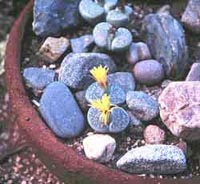Resource Library
Plant of the Week: Stones, Living
The University of Arkansas System Division of Agriculture does not promote, support or recommend plants featured in "Plant of the Week." Please consult your local Extension office for plants suitable for your region.
Plant of the Week
Living Stones
Latin: Lithops sp.

Failure is a part of gardening. I often tell people that if you don’t occasionally kill a few plants, you’re not trying hard enough.
Having killed more than my share of houseplants over the years, I’ve gradually come to the conclusion that succulents best fit my style of benign neglect. Yet, even some of these desert dwellers prove elusive, including the living stones.
Living stones are stemless succulents from South Africa that belong to the ice plant family. In nature they grow almost completely underground with only a pair of kidney shaped, succulent, flat-topped leaves exposed to the sky. The visible portion of the leaves function as a skylight and are mottled with green and brown and reach the size of a quarter.
The leaves look like the paintings of Northwest Arkansas’ artist, George Dombek, when he was in his "pebble" period, except that the plant has a cleavage line between the two leaves. The inside of each leaf is a transparent gelatinous mass which transmits light from the skylight to the side walls of the leaf where photosynthesis occurs.
In the spring, and sometimes in the fall, yellow or white cactus-like flowers, usually larger than the plant itself, emerge from the cleft between the two leaves. The resemblance of the living-stones’ flowers to those of the cactus family goes beyond superficial appearance and includes a unique set of pigments found exclusively in the two families.
These pigments point to a common ancestor of modern day cacti, which are native only to the New World, and members of the ice plant family which are found in Africa. It’s theorized that when South America and Africa were joined as one mammoth continent called Gondwanaland during the Cretaceous Period - about 100 million years ago - this ancestor was isolated into two communities when the continents drifted apart. Through eons of evolution the cactus family took on the familiar barbs for protection in arid climates while the African relatives developed a less prickly means of survival.
The living stones produce seeds in a capsule, which opens to expel seeds when it is moist and close to protect them when dry weather returns. These capsules are the main means of classification of the family. The ice plant family contains a number of Lithops-look-alike genera and, if DNA technology is ever brought to bear on the family, no doubt the relationship lines of the group will be significantly reordered.
The last batch of living stones I grew - and until the squirrels attacked they were actually growing - were an assortment of year-old seedlings in 2-inch pots. I’ve not sorted out in my own mind if squirrels are curious or just mean spirited, but they certainly seem to love the leaves of these fat little succulents. Lithops require well drained, gritty soil and bright light to survive. Because over watering is a constant threat, they are usually kept in small clay pots.
Typically, in their native haunts, they have two periods of inactivity during the year. During these periods of rest, watering should be reduced greatly. The rest periods are during our winter and summer months. In the spring and fall, they should be watered once or twice a week but never allowed to sit in a saucer that will hold water. Fertilization is on the light side, but a diluted houseplant fertilizer should be used during the beginning of the growth spurts of spring and fall.
By: Gerald Klingaman, retired
Extension Horticulturist - Ornamentals
Extension News - May 25, 2001
The University of Arkansas System Division of Agriculture does not maintain lists of retail outlets where these plants can be purchased. Please check your local nursery or other retail outlets to ask about the availability of these plants for your growing area.